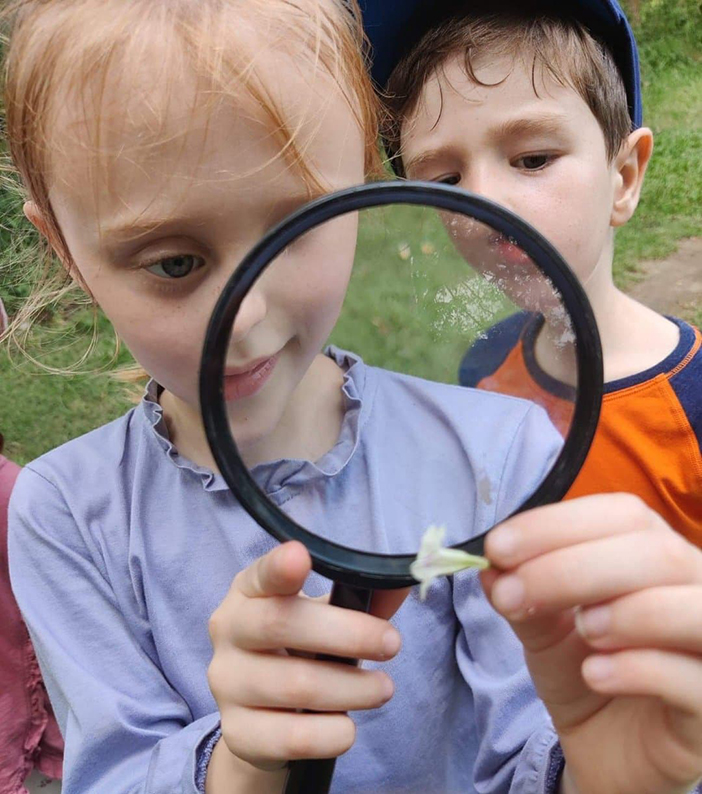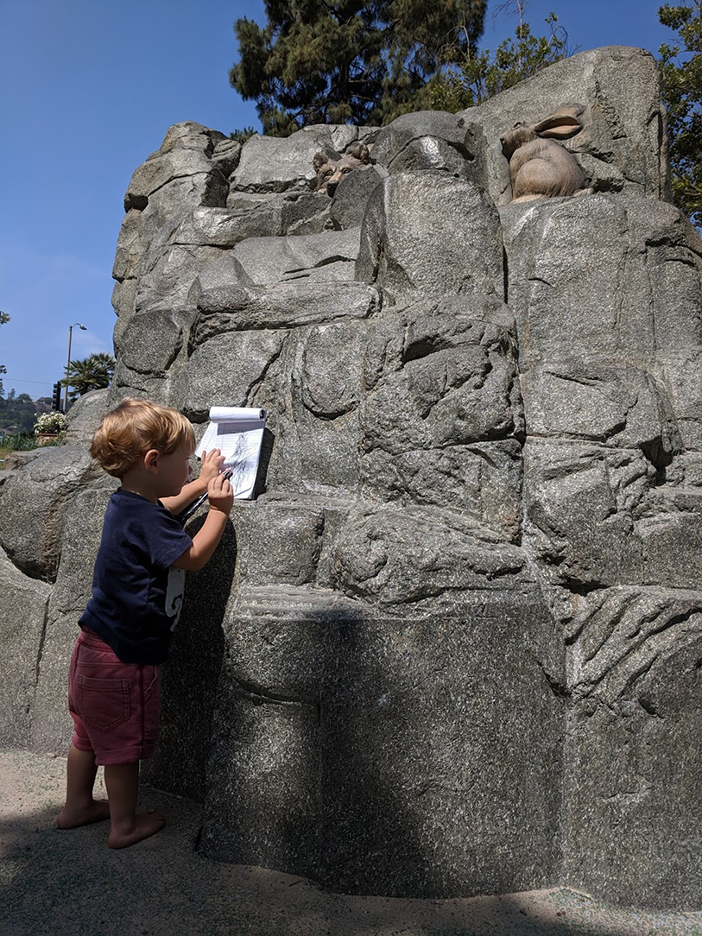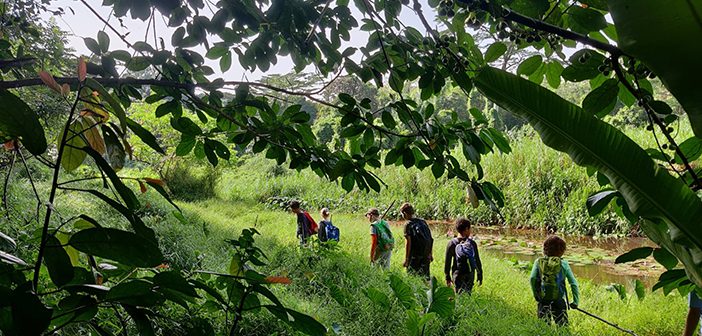Now that we don’t need three extra layers to leave our homes, there will be more chances to get outside and play! This time of year is ideal for good old nature play. But did you know that self-directed outdoor exploration is just as important for kids as classroom learning? It doesn’t have to look the same, however, and parents shouldn’t try to replicate the teacher-student relationship for a successful learning experience out in nature.
I am often guilty of stunting my child’s learning because I want to be sure we’re learning “correctly,” and I’m not entirely confident in my own knowledge on that subject. It got to the point where if I say I don’t know the answer to a question, my kids reply, “Just ask Google, Mommy.” And sure, I can type in a few keywords and tell them an answer, but when we’re outside, children are their own best teachers, and we can follow along as their co-teachers.
 “Parents need to rethink childhood,” says Parityada Punthapong, co-founder and director of Outdoor School Bangkok. Likewise, Kelly Goddard, founder of Forest Adventure Club in Singapore would agree. “We see so many planned activities, with endless provided resources, time boundaries and goal-oriented tasks, basically parents trying to lead play,” she says. “When adults lead, influence, or take over a child’s play they are violating the basic principles of play being self-chosen and self-directed by the child. When children lose the freedom to explore openly, the experience loses its meaning…When and if a child needs us, we are there.”
“Parents need to rethink childhood,” says Parityada Punthapong, co-founder and director of Outdoor School Bangkok. Likewise, Kelly Goddard, founder of Forest Adventure Club in Singapore would agree. “We see so many planned activities, with endless provided resources, time boundaries and goal-oriented tasks, basically parents trying to lead play,” she says. “When adults lead, influence, or take over a child’s play they are violating the basic principles of play being self-chosen and self-directed by the child. When children lose the freedom to explore openly, the experience loses its meaning…When and if a child needs us, we are there.”
That’s how Marina Robb, founder and managing director of Circle of Life Rediscovery Community Interest Company and The Outdoor Teacher Ltd, also describes it. And in a way, that can also help parents feel good about not always needing to “learn” or have a “lesson” for all of a child’s play: “We are creating open questions where we listen and value the children’s perspective, encouraging where necessary to extend their thinking or physical development. A human needs to feel loved and one of the ways of showing this as adults is to try to not close them down with your ‘knowledge’ but rather to open them up to possibilities.”
It’s still hard to release what we feel is our responsibility as parents, and here is where the concept of “scaffolding” a child’s learning comes into play – pun intended. It’s the easiest way to help a parent take a step back and allow the child to discover their own questions – and often their own answers.
What is Scaffolding?
Scaffolding as a teaching technique is exactly what its namesake makes you imagine: Rather than leading a child through their learning towards a specific end, parents can simply be there to support and elevate a child based on what they want to learn and where they show curiosity.
Allison McGilligan is a credentialed Forest School teacher in Malaysia, and she uses the example of encouraging a child to climb a tree to explain scaffolding.

• The biggest thing is allowing them to climb a tree, accepting that there may be an element of risk, age-appropriate risk.
• Say yes, have a go. And they probably won’t be able to do it without your help.
• Ask “How could you go up into that tree?” So you’re scaffolding their problem solving, you’re scaffolding their executive function of falling down a tree, or rolling down a hill, or picking something out of a puddle, but you need to give them the freedom to do that.
• The science behind this play process will tell you that a child needs something like a minimum of two hours of uninterrupted play for these synapses to connect in their brain, for that neurological pathway to evolve so that they learn from their experience and the next time they go do it, they will do it in a safer way.
• We only say “Be careful” if we see there is imminent danger. Instead, try “Oh, what do you notice about the tree that means you are going to have to keep yourself really safe when you’re climbing it today?”
• We’re giving the responsibility back to the child. And they can notice the detail. They can sit in nature and focus on one thing.
• We don’t tell, we support.
• We observe and then reflect on what we see the children are interested in.
• The skill of the educator is to weave in numeracy and phonics, into the color, sounds, and literacy development.
It’s much more fun to be a co-learner, McGilligan says, than try to know more than the child about everything in nature. She suggests allocating a shelf for their nature treasures, investing in one or two books based on the child’s interests, and do less online research and more offline research.
 This way of learning may not fit the standard societal concept of what a classroom is or should be, but gives children “an incredibly diverse sensory environment that promotes embodied understanding,” says Robb. “Starting life with confidence in your ability to discover, be risky enough to move your learning and development forward is a valuable foundation for later cognitive development. We forget that top businesses are looking for team-building, problem-solving, creative abilities, and emotional intelligence, which start from a good play-based direct confidence in the world.”
This way of learning may not fit the standard societal concept of what a classroom is or should be, but gives children “an incredibly diverse sensory environment that promotes embodied understanding,” says Robb. “Starting life with confidence in your ability to discover, be risky enough to move your learning and development forward is a valuable foundation for later cognitive development. We forget that top businesses are looking for team-building, problem-solving, creative abilities, and emotional intelligence, which start from a good play-based direct confidence in the world.”
Beyond mental health and learning, playing outdoors also has more long-term benefits than we might realize. Goddard believes that “The better connected with the outdoors children are, the more inclined and passionate they will be to respect and protect our natural world for themselves and future generations.”
And that’s a result worth exploring.
Some app suggestions to aid in co-teaching/co-learning:
NSS Bird Guide
Nature Passport
Weather
iNaturalist
Images: Cindy Marie Jenkins, Kelly Goddard, Canva
 This article appeared in the jingkids 2021 March issue
This article appeared in the jingkids 2021 March issue




